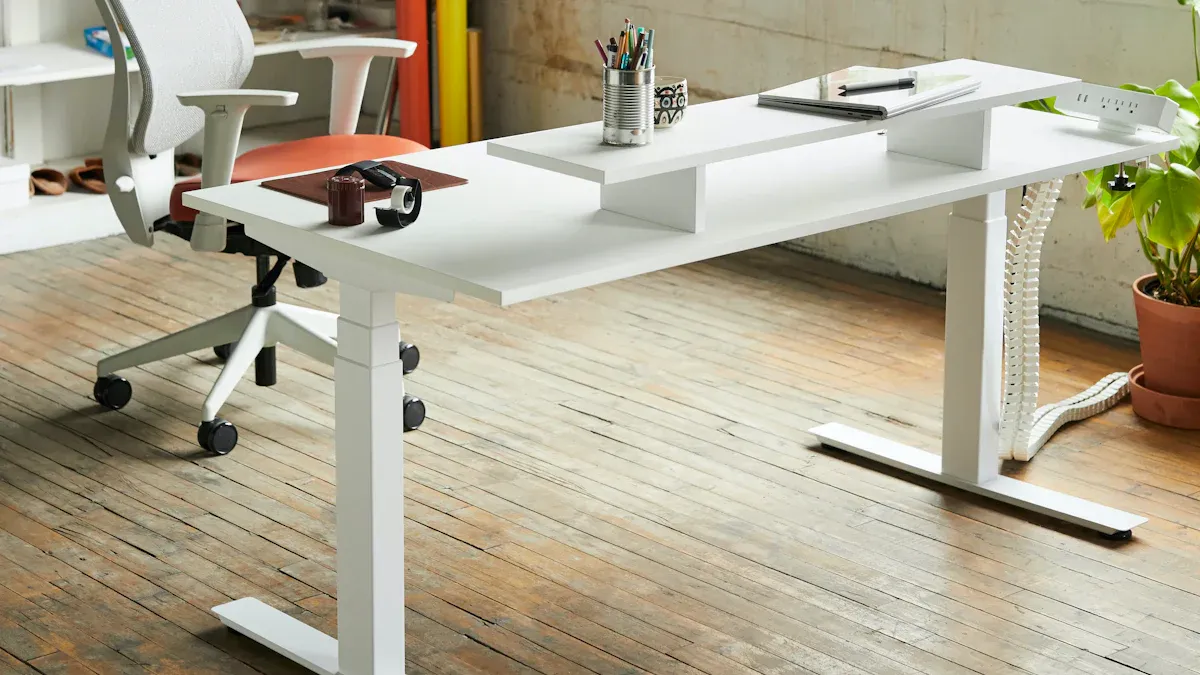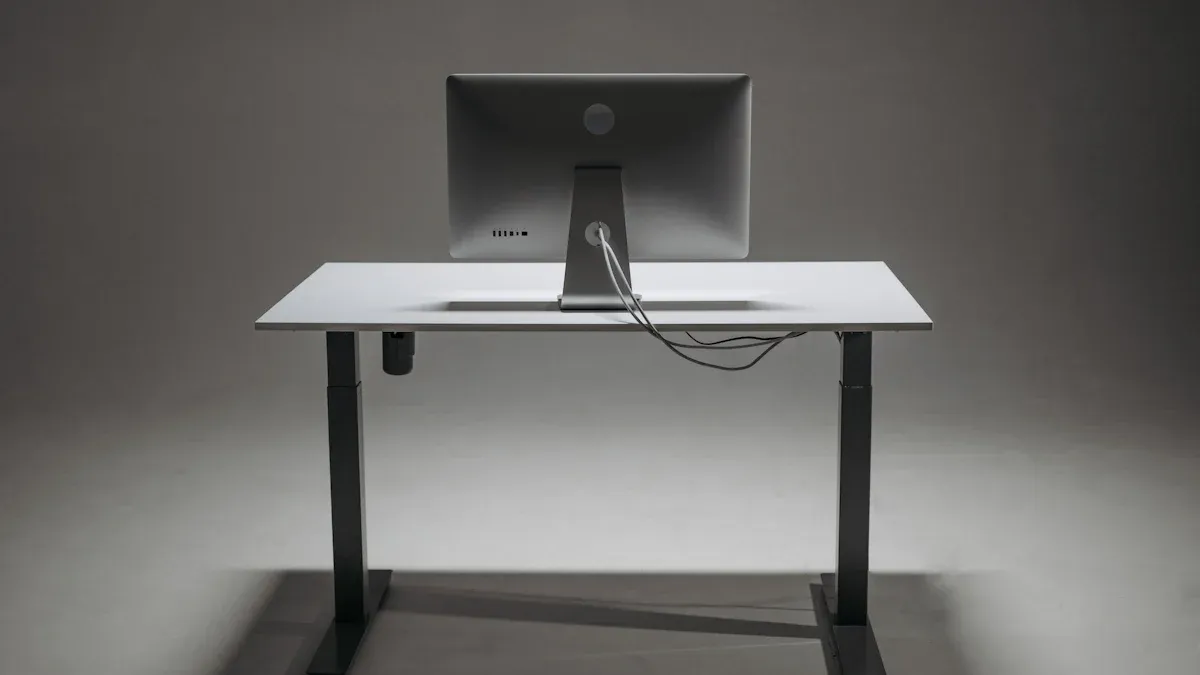
A pneumatic sit-stand desk uses air pressure to adjust its height smoothly. These desks typically support weights ranging from 20 to 220 pounds, depending on their design and construction. The lifting mechanism plays a key role in determining the weight limit. Materials like steel or wood also impact durability and capacity. For example, a Pneumatic Foldable Adjustable Desk may offer portability while maintaining strength. If you’re considering a china pneumatic sit-stand desk or a Pneumatically Adjustable Desk, knowing the weight capacity ensures your setup stays safe and functional.
Key Takeaways
- Pneumatic sit-stand desks can hold 20 to 220 pounds. Pick a desk that fits your current and future needs for best use.
- The lifting mechanism’s quality is very important. A strong mechanism makes height changes easy and handles more weight without trouble.
- Check your desk’s lifting parts often for damage or wear. Finding problems early can stop bigger issues and make your desk last longer.
- Add up the weight of all your equipment and accessories. Keep the total weight much lower than the desk’s limit for safety.
- Pick desks made from strong materials like steel or solid wood. These materials are sturdier and last longer, giving better support.
Typical weight capacity of a pneumatic sit-stand desk

Standard weight ranges across different models
Pneumatic sit-stand desks come in a variety of models, each designed to support a specific weight range. Most standard desks can handle between 20 and 150 pounds. Lightweight models, often used for smaller setups, typically support up to 50 pounds. These are ideal if you only need space for a laptop and a few accessories. On the other hand, heavy-duty models can support up to 220 pounds, making them suitable for dual-monitor setups, desktop computers, and additional equipment.
When choosing a desk, you should consider the weight of your current setup and any future additions. A desk that supports a higher weight range offers more flexibility and durability over time.
How pneumatic lifting mechanisms determine capacity
The pneumatic lifting mechanism is the heart of a pneumatic sit-stand desk. It uses compressed air to adjust the desk’s height smoothly and efficiently. The strength of this mechanism directly affects how much weight the desk can lift and hold. High-quality pneumatic systems are designed to handle heavier loads without compromising performance.
If the lifting mechanism is weak or poorly constructed, it may struggle to lift even moderate weights. This could lead to uneven adjustments or damage over time. To ensure reliability, you should look for desks with robust pneumatic systems made from durable materials. Manufacturers often specify the weight capacity of the lifting mechanism, so checking this detail can help you make an informed decision.
Examples of popular models and their weight limits
Several popular pneumatic sit-stand desk models showcase a range of weight capacities. For instance:
- FlexiSpot Pneumatic Desk: This model supports up to 150 pounds, making it a great choice for most home office setups.
- Uplift Pneumatic Standing Desk: With a weight capacity of 220 pounds, this desk is perfect for heavier equipment like multiple monitors and desktop towers.
- VariDesk Pneumatic Pro Plus: Designed for lighter setups, this desk supports up to 50 pounds and is ideal for laptops and minimal accessories.
These examples highlight the importance of matching the desk’s weight capacity to your specific needs. By doing so, you can ensure the desk operates smoothly and lasts longer.
Factors influencing the weight capacity of pneumatic sit-stand desks
Impact of desk design and materials
The design and materials of a desk play a major role in determining how much weight it can support. A desk made from high-quality materials like steel or solid wood will generally hold more weight than one made from plastic or particleboard. Steel frames provide excellent strength and stability, while solid wood surfaces resist bending under heavy loads.
The design also matters. Desks with reinforced frames or crossbars distribute weight more evenly, reducing the risk of wobbling or tipping. Adjustable legs or wide bases add extra support, especially for heavier setups. When choosing a pneumatic sit-stand desk, you should look for models with sturdy construction and durable materials to ensure long-term reliability.
Role of the pneumatic lifting mechanism’s quality
The quality of the pneumatic lifting mechanism directly affects the desk’s weight capacity. A high-quality mechanism uses strong, well-sealed components to handle heavier loads without losing performance. It ensures smooth height adjustments even when the desk is fully loaded.
Cheaper mechanisms may struggle to lift moderate weights, leading to jerky movements or uneven adjustments. Over time, this can damage the desk or make it unsafe to use. To avoid these issues, you should check the manufacturer’s specifications for the lifting mechanism. Look for desks with mechanisms tested for durability and weight capacity. This ensures your desk can handle your setup without compromising safety or functionality.
Influence of desk size and surface area
The size and surface area of a desk also influence its weight capacity. Larger desks often support more weight because they distribute the load across a wider area. However, this depends on the strength of the frame and the materials used. A large desk with a weak frame may sag or become unstable under heavy loads.
Smaller desks, while compact, may have lower weight limits. These are better suited for minimal setups with fewer items. When selecting a pneumatic sit-stand desk, you should consider the size of your workspace and the equipment you plan to use. A desk that matches your needs will provide better stability and performance.
Calculating the total weight of your setup

Adding up the weight of essential equipment
Start by listing the core items you plan to place on your desk. These typically include your computer, monitor(s), keyboard, and mouse. Check the weight of each item, which is often listed in the product manual or on the manufacturer’s website. For example:
- A standard laptop weighs around 3 to 5 pounds.
- Monitors can range from 5 to 15 pounds, depending on their size.
- Keyboards and mice usually add another 2 to 3 pounds combined.
Add these weights together to get a baseline for your setup. If you use multiple monitors or a desktop tower, make sure to include those as well. Knowing the total weight of your essential equipment helps you determine if your pneumatic sit-stand desk can handle the load.
Considering additional items like decor or accessories
Beyond the essentials, think about any extra items you might place on your desk. These could include desk lamps, books, plants, or decorative objects. While these items may seem light, their combined weight can add up quickly. For instance:
- A small desk lamp might weigh 2 to 4 pounds.
- A stack of books could easily add 10 pounds or more.
- Potted plants vary widely but can weigh anywhere from 3 to 10 pounds.
To avoid surprises, weigh or estimate the weight of each item and add it to your total. This ensures you account for everything on your desk.
Tip: Keep your workspace clutter-free by limiting non-essential items. This not only reduces weight but also improves productivity.
Ensuring the total weight stays within the desk’s capacity
Once you’ve calculated the total weight of your setup, compare it to the weight capacity of your pneumatic sit-stand desk. If the total weight is close to the desk’s limit, consider removing some items or opting for a higher-capacity model. Overloading the desk can strain the lifting mechanism, leading to uneven adjustments or long-term damage.
Always aim to stay well below the maximum weight capacity. This provides a safety margin and ensures smooth operation. By carefully managing the weight of your setup, you can extend the life of your desk and maintain its performance.
Choosing the right pneumatic sit-stand desk
Matching the desk to your current and future needs
When selecting a pneumatic sit-stand desk, consider your current setup and any future changes. Start by assessing the weight and size of your equipment. If you use a single monitor and a laptop, a lightweight desk may suffice. For dual monitors or heavier items, choose a model with a higher weight capacity.
Think about how your needs might evolve. You may add more devices or accessories over time. A desk with adjustable features and a robust lifting mechanism can adapt to these changes. Prioritize flexibility to avoid replacing your desk as your workspace grows.
Tip: Choose a desk with extra surface area if you plan to expand your setup. This ensures you have room for additional items without compromising stability.
Evaluating product specifications and reviews
Product specifications provide valuable insights into a desk’s performance. Look for details like weight capacity, materials, and dimensions. These factors determine whether the desk can support your setup effectively. Pay attention to the quality of the pneumatic lifting mechanism, as it impacts smooth height adjustments.
Customer reviews offer firsthand experiences. Read reviews to learn about durability, ease of use, and potential issues. Focus on feedback from users with similar setups to yours. Positive reviews about reliability and performance can guide your decision.
Note: Avoid desks with frequent complaints about lifting mechanisms or stability. These issues may lead to frustration and reduced functionality.
Considering the desk’s durability and warranty
Durability ensures your desk lasts for years. Desks made from steel or solid wood often provide better strength and stability. Check for reinforced frames or crossbars that enhance support. A sturdy desk resists wear and tear, even with daily use.
Warranty coverage adds peace of mind. Manufacturers offering longer warranties often stand behind their products. Look for desks with warranties covering the lifting mechanism and structural components. This protects your investment and ensures repairs or replacements if needed.
Reminder: Always review warranty terms before purchasing. This helps you understand what is covered and for how long.
Maintenance and safety tips for pneumatic sit-stand desks
Regularly inspecting the lifting mechanism
You should inspect the lifting mechanism of your pneumatic sit-stand desk regularly. Look for signs of wear, such as unusual noises, uneven movement, or difficulty adjusting the height. These issues may indicate that the pneumatic system needs attention. Check the seals and connections to ensure they remain tight and free from damage. If you notice any problems, address them immediately to prevent further damage. Regular inspections help maintain the desk’s performance and extend its lifespan.
Tip: Schedule a quick inspection every month to catch potential issues early.
Avoiding overloading the desk
Overloading your desk can strain the lifting mechanism and compromise its stability. Always stay within the weight capacity specified by the manufacturer. Calculate the total weight of your setup, including all equipment and accessories, to ensure it does not exceed the limit. If you frequently add or remove items, reassess the weight to avoid accidental overloading. Keeping the load light ensures smooth adjustments and prevents long-term damage.
Reminder: Even if the desk seems stable, exceeding the weight limit can cause hidden stress on the components.
Cleaning and maintaining the desk for longevity
Keeping your desk clean and well-maintained improves its functionality and appearance. Use a soft, damp cloth to wipe the surface and remove dust or spills. Avoid harsh chemicals that could damage the finish. For the lifting mechanism, ensure it remains free of debris that could interfere with its operation. Lubricate moving parts if recommended by the manufacturer. Proper cleaning and maintenance keep your desk looking new and working efficiently for years.
Note: Regular cleaning also creates a more pleasant and productive workspace.
A pneumatic sit-stand desk offers flexibility and supports weights ranging from 20 to 220 pounds. Its design, materials, and lifting mechanism determine how much weight it can handle. You should calculate the total weight of your setup and stay within the desk’s capacity to ensure safe use. Regular maintenance, like inspecting the lifting mechanism and avoiding overloading, keeps the desk functional for years. By understanding these factors, you can maximize the desk’s performance and longevity.
FAQ
1. How do I know if my desk is overloaded?
Check the total weight of your setup, including equipment and accessories. Compare it to the desk’s specified weight capacity. If the desk struggles to adjust smoothly or shows signs of strain, you may have exceeded the limit.
Tip: Always stay below the maximum capacity for safety.
2. Can I repair a faulty pneumatic lifting mechanism?
Yes, but it depends on the issue. You can fix minor problems like loose seals or connections. For major issues, contact the manufacturer or a professional. Avoid DIY repairs that could void the warranty.
Reminder: Regular maintenance prevents most lifting mechanism problems.
3. Are pneumatic sit-stand desks noisy?
No, most pneumatic desks operate quietly. The air pressure system ensures smooth and silent height adjustments. If you hear unusual noises, inspect the mechanism for wear or damage.
Note: A well-maintained desk remains quiet and efficient.
4. Do pneumatic desks require electricity?
No, pneumatic sit-stand desks don’t need electricity. They rely on air pressure for height adjustments, making them energy-efficient and portable. This feature also eliminates the need for power outlets.
5. How long does a pneumatic desk last?
A high-quality pneumatic desk can last several years with proper care. Regular cleaning, avoiding overloading, and inspecting the lifting mechanism extend its lifespan. Durable materials like steel or solid wood also contribute to longevity.
Tip: Check the warranty for an idea of the expected lifespan.
Post time: Jun-04-2025
